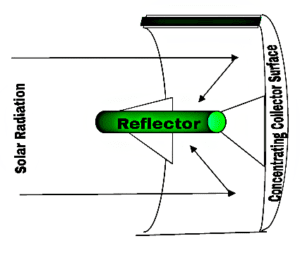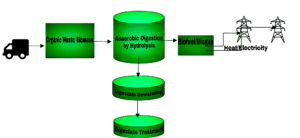Renewable Energy Meaning, Types, Comparison and Examples
Renewable energy is energy which is derived from renewable, natural sources.
The global society of today is very active in science, industry and technology. In the various fields that make up these sectors, there have been numerous innovations in recent years.
One of the most important elements that drive the sustainable development of science and technology is energy. And, recently, the high demands on energy sources have led to increased public interest on these sources of energy and their environmental effects.
In this article, Renewable Energy will be discussed extensively. The areas of focus include;
1). Meaning of Renewable Energy
2). Examples of Renewable Energy Sources
3). Examples of Renewable Energy Technologies
4). Analysis of Renewable Energy Technologies
* What is Renewable Energy?
As the term implies, ‘Renewable’ energy refers to those forms of energy that can be derived from natural, renewable sources. These sources are called ‘renewable’ because they are naturally replenished after being consumed or used.
The Main Types of Energy
It is important to understand that Renewable Energy is one of the two main types (or categories) of energy. The other type of energy is called Non-Renewable Energy.
Just as Renewable Energy sources can be replenished or recovered naturally, the Non-Renewable Energy sources cannot be recovered in such a simple manner. Non-Renewable Energy may also be called ‘Unclean’, ‘Dirty’, or ‘Unsustainable’ energy. In the same vein, we can call Renewable Energy ‘Clean’, or ‘Sustainable’. Non-Renewable Energy Sources include nuclear energy, as well as fossil fuels like Coal, Natural Gas and Petroleum [13].
* Other ways we can define Renewable Energy
Renewable Energy can be described as a cheaper and more innovative replacement for Non-Renewables like fossil fuels. It is a form of energy that solely uses naturally available and easily accessible elements as sources.
Renewable Energy is energy that comes from sources which are continuously and consistently replenished by nature. These aquatic, aeolian, terrestrial and vegetative sources.
Difference Between Renewable Energy and ‘Clean Energy’
The terms Renewable and Clean, are often used interchangeably to describe energy that can be derived from sustainable, natural sources.
However, Renewable Energy refers specifically to energy from sources that can be recycled by nature. This is slightly different from Clean Energy, which refers to energy that is environment-friendly and does not pollute the soil, water or atmosphere.
The reason for the overlapping of these two concepts is the fact that most natural, recyclable energy sources do not have any significant negative impacts on the environment. Therefore, they may be considered ‘clean’ as well.
However, some types of renewable energy are not clean, as they are harmful to the environment. An example is Hydro-energy, which can lead to extensive flooding and can destroy habitats [21].
Also, Non-renewable and ‘Unclean’ energy sources can be used to produce energy that we can consider ‘Clean’. In such cases, the produced energy is not renewable, but clean. We can find an example of this in the use of fossil fuels to produce electricity that powers electric cars.
Is Renewable Energy Technology a New Development?
Renewable Energy is highly innovative, and has undergone numerous series of developments over the years.
However, it is not an entirely new concept. The use of natural sources as energy-producing media is a practice which has existed for several centuries before the advent of modern technology.
For example, windmills have been used to grind grains, and sails in ships harnessed wind energy for increased speed. Modern renewable energy development has only provided a more innovative, cheaper and broader approach to the use of natural energy sources.
* Comparison between Renewable and Non-Renewable Energy
Non-Renewable energy sources became prominent a few centuries back. This was especially as a result of the industrial revolution which began to take place in some parts of the world at that time [6].
For Example, in the United States of America, the Nineteenth Century was marked by a rise in the rate and scale of industrial development. This involved the construction of extensive railways, bridges, in the building of large steam engines and the manufacture of iron [4]. These processes all required large amounts of heat energy, which was supplied by Coal; a Non-Renewable fossil fuel.
In Germany, the Nineteenth Century also saw the increase in combustion and smelting processes. Steel and textile manufacture, industrial construction and mechanization on an extensive scale made it necessary to use fossil fuels. This was similar in Britain, in the Mid-Eighteenth to Nineteenth Century [2].
The modern discovery of petroleum in 1847 by James Young led to the shift from coal and the oil rush of the nineteenth century [1].
The Oil and Gas industry has since excelled tremendously, because hydrocarbons have high energy density compared to most other sources.
Economic growth, industrialization and population increase have all increased the rate of usage of oil and gas. These products and other fossil fuels have been used extensively for domestic, industrial and commercial purposes. Gasoline is used in the internal combustion engine of vehicles and generators. Natural gas is used as a cooking fuel.
Environmental issues which have arisen due to fossil fuel usage have led to the understanding of the importance of renewable energy sources. This importance is due to the significant ways in which renewable energy differs from nonrenewable energy. A few points of disparity are given below;
Differences in the Characteristics of Renewable and Non-Renewable Energy Resources
| Non-Renewable Energy | Renewable Energy |
| Is derived from sources that cannot be replenished by nature | Is derived from sources that can be replenished by nature |
| Was developed fully in the nineteenth century | Modern developments began in the twentieth century |
| Sources usually have high energy density compared to renewable sources | Sources have generally lower energy density relative to nonrenewable sources |
| Is usually derived from sources that occur in the earth | Is usually derived from sources that occur on the earth (surface) |
| Is replenished at a slow rate compared to the rate of consumption or use | Can be replenished at an equal rate as the rate of consumption or use |
| The extraction and use of energy sources is usually harmful to the environment | The use of energy sources does not usually require any form of extraction, and is often environment-friendly |
| Nonrenewable sources of energy may be found in some specific regions of the world | Renewable energy sources are present in all regions of the world |
| The energy sources can only be harnessed using well-defined and monitored methods and processes | A flexible approach can be used to harness this form of energy, due to its relatively safe attributes and abundant supply |
| Energy sources are generally similar in their composition, intensity, availability, flexibility, measurement, mode of use and % energy share | Energy sources are highly variable in their compositional characteristics, availability, intensity, flexibility, measurement, mode of use and % energy share |
| The regeneration of energy sources usually requires long and complex natural processes like putrefaction, anoxic decomposition, and diagenesis | The regeneration of energy sources usually requires relatively simple, short-term natural and ecological processes like solar radiation, rainfall, and nutrient cycling |
| The process of harnessing energy sources has contributed to global warming and climate change | The process of harnessing energy sources has little to no effect on the climate and atmosphere |
The above table can be summarized to state that renewable energy is derived from sources that are environment-friendly, and easily replenished by short-term natural processes.
On the other hand; nonrenewable energy is derived from sources whose extraction and usage may affect the earth and climate in negative ways. These sources are also uneasily replenished and may take long periods to be recovered when used.
Examples of Renewable Energy
Renewable energy can be gotten from various sources and processes.
In order to highlight the different examples that represent renewable energy, we must consider two dimensions by which renewable energy can be defined;
1). Energy Resources
2). Energy Technologies
Examples of Renewable Energy Resources
Energy Resources has to do with the natural factors or elements that can produce energy.
In the case of renewable energy, the resources which can be harnessed to produce this form of energy are numerous. They are also generally derived from natural and ecological processes, as has earlier been stated.
Examples of renewable energy resources are as follows;
-Wind
What are two definitions of Wind?
Wind refers to moving air which surrounds an area or region.
Wind can also be defined as forceful air-motion that is caused by differences in gaseous pressure in the atmosphere.
Wind has been harnessed as a source of energy since ancient times. This includes its use in windmills as mentioned earlier in this article. The use of wind energy is relatively simple. It involves converting the kinetic energy of moving air currents, to other required forms of energy. These required forms may include mechanical and electrical energy, among others.
Although wind is ubiquitous and infinite in quantity, the use of wind as an energy source is most applicable in some areas. This includes urban and semi-urban regions where there is no obstruction of wind flow by high buildings and other structures. It also includes semi-arid and arid regions where the climate is more dry and aeolian in nature.

-Water
The fact that water occupies more than seventy percent (70%) of the earth surface makes it a highly abundant element on earth.
Water has been used as a source of energy due to its ability to flow continuously in large volumes. Flowing water provides a tremendous amount of kinetic energy that can be harnessed and converted to the required form(s).
The use of water as a renewable energy resource requires the presence of large water bodies like seas and oceans. There are also various approaches by which water resources can be used to produce energy. In general, water is described as a renewable energy resource because it is driven by the earth’s gravitational force, and recycled by natural geochemical processes [20].
Water can be considered to be a very ‘clean’ or ‘green’ source of energy. This is because its usage does not release any form of gaseous pollutant into the atmosphere. It is also vital to other ecological processes that help regenerate both renewable and nonrenewable energy sources (recall that nonrenewable energy sources can be regenerated as well, but at a slow rate compared to renewables).

-Soil
While it is not extremely popular in this regard, soil is in fact a major source of renewable energy. This assertion can be explained in a few different ways;
1). Component of the Energy Cycle
Soil is a notable component of the process of energy cycling in nature. It acts as a reservoir of energy. This is because most energy-producing elements return to the soil after their use, and are replenished through processes that occur in the soil.
Much of the soil’s energy is stored as biochemical energy, which it may release as nutrients to plants. We can observe evidence of the existence of soil biochemical energy in the use of Microbial Fuel Cells (MFCs) which convert this energy to electrical energy [9].
2). Source of Nutrient to Vegetation and Soil Organisms
The soil is indirectly the sole source of nutrient to the entire ecosystem.
Vegetation is known to thrive on nutrient supply, including phosphorus, potassium and nitrogen. These elements are all stored in soil water, which is retained by the soil.
Also, the soil harbors some important organisms like earthworms and termites, whose activities increase the rate at which these nutrients are produced. In turn, the soil supplies sustenance and shelter to such organisms.
Other important renewable energy sources like biomass, are supported by the soil in their replenishment and growth.
3). Sequestration of Carbon dioxide (CO2)
Carbon dioxide sequestration in soil is the process by which soils naturally trap and store CO2 through microbial activities.
Soil carbon sequestration helps drive sustainable development on earth by mitigating global warming and climate change. It also reduces the rate of ozone layer depletion, causing the use of solar energy (a Renewable energy resource) to be more efficient [8].
-Vegetation
Vegetation, which refers to plants, are a valuable source of energy.
Also, vegetation is easily replenished because plants can regrow in a relatively short period of time after they die or are removed for various purposes.
Vegetation is a highly abundant resource in the environment, occurring in basically every part of the world. This makes it very easy to access on large quantities compared to other renewable resources.
We can understand how vegetation is a source of renewable energy by considering the process of Photosynthesis. This is a natural process by which sunlight energy is trapped and converted by plants to form chemical energy, also called ATP (acronym for Adenosine Tri-Phosphate). Based on this, we can consider vegetation to be a natural Solar Battery [12]
The massive amounts of energy which plants store through photosynthesis, can be harnessed in different ways.
One of these ways is through the production of biofuels like methane (biogas) and ethanol. Another is the direct use of plant matter (biomass) as fuel.
Vegetation as a source of renewable energy, requires relatively simple conversion processes to be utilized. It is currently in its developmental stage.
-Sunlight
Sunlight is known to produce solar energy, which can be converted into various usable forms. These include light, heat and electricity.
The Sun is the source of much of the energy on earth [11]. This is because sunlight has energetic, radiant properties and can impact objects within its reach.
Sunlight is also an essential factor in the origin and development of other renewable energy sources. For example, it is required for Photosynthesis, which helps plants store energy in form of carbohydrate. It is also active in evaporation and precipitation, two processes which are important to the water cycle.
-Geothermal heat
This is yet another important example of a renewable energy resource.
The word Geo-thermal is gotten from the Greek language, where Geo means ‘Earth’ and Therme means ‘Heat’. Combining these together will help define geothermal energy as heat energy from the Earth.
Geothermal heat produces energy from within the earth. This implies that there is heat energy stored in the internal regions of the earth.
What is the Source of Geothermal Energy?
There have been different speculations regarding the actual source of geothermal heat energy.
One of these is the heat which was retained in the core of the Earth after its formation. This idea suggests that geothermal heat is derived from stored thermal energy that has bee retained in the earth for billions of years since its origin. The concept may be supported by the Big Bang Theory, which states that the origin of the Universe (which includes the Earth) involved explosive reactions and large amounts of heat.
Geothermal heat can be used to provide energy for a variety of purposes, as will be discussed in the next section.
Examples of Renewable Energy Technologies
-
Solar Energy Technology
Solar renewable energy technology may be developed in any of three main forms.
These are the concentrating solar power (CSP) technology; the solar cooling (SC) technology; and the Photovoltaic technology [19].
* The Concentrating Solar Power (CSP) Technology is designed to collect as much solar energy from sunlight, as possible, then to focus (or concentrate) this energy unto a small surface area. This surface area is usually called the receiver.
This mechanism helps to produce high-intensity solar radiation, which can be converted into other forms of energy like electricity and heat.
The instrument used is called a Concentrating Solar Collector. It basically is comprised of highly reflective surfaces which are inclined at such angles as will help to deflect solar radiation in the required direction.
What are the Types of Concentrating Collectors?
The types of concentrating collectors can be defined based on the geometry or shape of the collector.
Based on this means of categorization, there are four main types, which are the Parabolic or Trough collector, Dish collector, Linear (Fresnel) collector, and Tower collector.




The system which makes use of concentrating solar collectors is called a concentrating solar power (CSP) plant.
In most cases, these solar power plants use solar radiation from the CSP collectors, to derive heat. This heat is then in turn used to drive steam turbines and engines that can generate electricity. The conversion process is therefore as follows;
Solar Energy – Thermal Energy – Electricity
Concentrating Solar Power Technology has the advantage of its ability to improve the efficiency with which solar energy can be harnessed. Unlike other solar renewable technologies, this type is able to collect relatively large amounts of solar radiation within a relatively small surface area. It thereby produces higher energy density in its output, than other solar technologies.
* Solar Cooling (SC) Technology is driven by processes that use solar radiation as an instrument for temperature regulation.
This example of renewable technology involves the use of Solar Cooling Systems, which are of two main types including solar thermal and solar electric cooling systems.
The solar thermal cooling system collects radiant energy from the sun, using it as a source of heat to drive thermal processes like adsorption, desiccation and absorption.
The solar electric cooling system provides solar radiation which is converted to electricity for powering electric cooling mechanisms like the Heat, Ventilation and Air-Conditioning (HVAC) systems.
Solar Cooling Technology serves as a viable means of cooling in hot regions of the world. t reduces the cost of running cooling systems by replacing electricity as a driver of adsorption and evaporation, and other processes that help remove heat from buildings.
It is also possible to refer to Solar Cooling Technologies as Solar Heating and Cooling Technologies (SHC). This is because the solar radiation collected by solar cooling systems may also be used to supply heat energy for domestic and industrial purposes. These could include space heating, steam engine-driving, and water heating processes.
*Photovoltaic (PV) Solar Renewable Technology is one of the most common forms of renewable energy technologies in our modern society.
Photovoltaic technology is a unique method of harnessing renewable energy. This is because it is highly economical, and environment-friendly.
This technology involves the use of photovoltaic cells to convert solar radiation to electricity. It is based on the Photovoltaic Effect.
Albert Einstein provided a vivid explanation for the photoelectric effect, by showing that light may act as a wave and a particle. This particle is said to possess energy and is referred to as a photon. It may be determined by multiplying the frequency of oscillation of the particle by Planck’s constant, as shown below;
E = hν —(1)
Where;
v = Frequency of the light Particle; and
h = Planck’s constant = 6.6261 × 10-34 Js.
When solar radiation falls on metallic surface, electricity may be generated, through the photovoltaic effect. The photovoltaic effect results in the production of electricity, because these photons can transfer their energy electrons with which they collide. Therefore, the electrons are energized and leave the surface of the metal.
Initially, the energy is transferred to the electrons in form of Kinetic energy. It is the flow of these energized electrons that results in electric current.
It is estimated that the energy required to eject electrons from the metallic surface (called the ‘work function’) and the kinetic energy of the charged electrons, sum up to give the energy of the photon. This is represented mathematically as follows;
E = W + KE —(2)
or
hv = W + KE —(3)
Where;
E= Energy of photon
K= Maximum kinetic energy of the electron
W= Required energy to eject an electron (work function)
Photovoltaic technological systems make use of solar cells (or photovoltaic cells), which are made of the semiconductor material; silicon. These cells are the units in which solar energy is converted to electricity. An array of solar cells can be referred to as a Solar Panel.
The terms Solar and Photovoltaic both refer to renewable energy that is gotten from the Sun.
However, photovoltaic technology makes use of the photovoltaic effect to convert solar radiation to electricity. In the case of solar technologies, this conversion may not always take place.
A simplified comparison between solar and photovoltaic renewable technologies is given in the following table;
| Solar | Photovoltaic |
| Is dependent solely on the collection of solar radiation | Depends on the collection and Conversion of solar radiation to produce electricity |
| Energy is often harnessed in the form of heat | Energy is harnessed in form of electricity |
| Is driven by solar thermal process | Is driven by solar photovoltaic process |
| Energy usage may involve the emission of gaseous matter like Steam | Energy usage is usually ‘clean’ without any form of emission |
| Often involves the use of reflective collectors | Involves the use of photovoltaic silicon collectors |
| The process of energy usage is relatively complex | Process of energy usage is relatively simple |
-
Biomass Energy (Bioenergy) Technology
Biomass simply refers to organic matter that is derived from animals and plants. It is renewable, since these plants and animals are ever present on earth, being continuously replenished by nature.
Before the industrial revolution of the nineteenth century, biomass accounted for a huge proportion of the energy consumption in the United States and across the continent of Europe [5].
In developing countries of the world, biomass is still being used domestically as a fuel and renewable source of energy. Recent developments in developed countries seek to modify biomass usage, to make it more efficient, effective and safe.
One of such efforts is through the production of biogas. This gas is basically methane, which can be derived from the process of decomposition of biomass. It is therefore referred to as a biofuel, and several efforts have been made so far, to develop biogas processing plants which can harness this renewable fuel.
Is Bioenergy a ‘Clean’ form of Energy?
It is very important to use bioenergy as an example, when distinguishing between Renewable and Clean energy. Although biomass which produces bioenergy, is renewable, the development and use of bioenergy emits greenhouse gases like methane and carbon dioxide (CO2).
Therefore, bioenergy is renewable, but not ‘clean’ or environment-friendly.
What is an Example of Bioenergy?
Bioenergy is usually derived in form of heat, which can be converted to other quantities like electricity.
An example of bioenergy is the heat from burning firewood. This heat can be used for domestic purposes like heating, lighting and cooking.
Based on these observations, we can categorize bioenergy technologies into two main types. These are the traditional and modern types of bioenergy technology.
The traditional type of bioenergy technology refers to the simple methods of burning biomass (such as firewood) to produce heat energy. The modern type of bioenergy technology involves the production of liquid and gaseous biofuels. These fuels are produced from biological matter or Biomass through the industrialized process of Anaerobic Digestion.

Process of Anaerobic Digestion
What are Examples of Biomass?
As earlier stated, biomass includes organic materials derived mainly from animals and plants.
Examples of Biomass include the following;
1). Wood
2). Leaves
3). Sewage
4). Dead animal Remains
5). Husks
6). Seeds
What is Biofuel? and what are Examples of Biofuel?
As the name suggests, biofuels are energy-producing substances that are derived from biomass.
Examples of Biofuel are;
1). Methane (biogas)
2). Ethanol (biofuel)
What processes lead to Production of Biofuel?
1). Decomposition
2). Hydrolysis
3). Fermentation
4). Methanogenesis
-
Wind Energy Technology
We may often think of wind as only an element of geography, weather and climate. However, wind energy technology provides an innovative aspect of wind energy that has been consistently growing over the past few decades. Wind energy can be harnessed as a renewable source of power for numerous purposes.
How does Wind Energy Technology Work?
The principle behind wind energy technology, is simply the conversion of kinetic energy of wind, to other usable forms of energy.
In order to achieve this purpose, a Wind Turbine is used. This instrument is comprised of blades, which are linked to an electricity-generating system. A wind turbine is illustrated below;

A simplified depiction of the energy conversion process is as follows;
Kinetic Energy (Wind) – Mechanical Energy (Blades and Rotor) – Electricity (Generator)
The electric current produced by the generator is converted from DC to AC using an inverter, before it is channeled to the point of use [18].
Do Wind Turbines Require Electricity to Operate?
As we may observe from the discussion in this section; Wind Turbines are electricity-generating systems. This means that they do not require any other source of power asides wind energy to operate.
4. Wave Energy Technologies
We can consider wave energy technology to be a novel and developing renewable energy technology in the world.
This technology makes use of systems called Wave Energy Converters (WECs). The basic function of wave energy converters is to make use of the energy contained in surface waves in seas and oceans, to produce electricity.
What are the Types of Wave Energy Technologies?
There are five (5) main types of wave energy technologies. We may also refer to them as types of wave energy converters. These are as follows;
* Absorbers
Also known as Point Absorbers, these wave energy converters use the relative motion between a wave-driven body and a stationary body that is unaffected by wave energy
The moving body is usually the part of the device which is in contact with the waves, and the stationary body is usually the plate, which rests on the seabed.
Point absorbers convert this relative motion (kinetic energy) from waves to mechanical energy in a rotor system which drives a generator to produce electricity.

*Oscillation water columns
Oscillation Water Columns (OWCs) are wave energy converters that are comprised of a hollow chamber which is partially submerged in the sea or ocean.
The oscillatory motion of waves in the sea or ocean produce high gaseous pressure in the hollow column, which can be converted to mechanical energy.
This gas pressure may be used to drive a turbine, which generates electricity.
* Attenuators
The attenuator is essentially a long column of hollow cylindrical vessels which are linked to each other.
Also known as the ‘Sea Snake’ [16], this device is allowed to float on the sea surface. The energy of waves which come in contact with the vessels is used to drive a hydraulic motor, which powers an electricity generator.
* Overtopping Wave Energy Converter
This is a wave energy converter device which captures high-energy waves which flow over its top, into a reservoir. The device is designed like an offshore dam [17], and breaking waves which collide with its slanted edge may flow into the reservoir, depending on their height and energy.
The water which fills the reservoir at high pressure is used to drive a turbine, which in turn drives an electricity generator.
* Inverted- Pendulum Wave Energy Converter
Also known as the ‘Oscillating Wave Surge Converter’, this device comprises of a paddle which is hinged on a movable pivot like an inverted pendulum structure.
When ocean waves come in contact with the device, it moves the paddle in a bi-directional manner. This creates an oscillatory motion (mechanical energy) that is used to drive a hydraulic pump. The hydraulic pump in turn powers an electricity generator.
Aside wave energy technology, there are three other technologies that make use of oceans and seas as the source of renewable energy.
What are the four Types of Ocean Energy Technology?
The four main types of wave energy technology include;
1). Tidal
2). Ocean Thermal
3). Salinity Gradient, and;
4). Ocean wave energy technology [7]
What are the Disadvantages and Advantages of Wave Energy Technologies?
Wave energy technologies have the advantage of being able to provide very large amounts of energy at a consistent rate.
The main disadvantage however, is the cost of full development of wave energy converter systems. Also, it is generally difficult to build an efficient mechanism to transport the electricity produced, to the point where it is needed.
Lastly, wave energy technologies are geographically restricted, since they can only be used where there are large water bodies like seas and oceans.
5. Geothermal Energy Technology
What are Geothermal Energy Technologies?
This example of renewable energy technology, simply makes use of the geothermal heat energy of the Earth. The applications of geothermal energy technologies include space cooling and heating, and electricity generation [14].
In geothermal energy technological operations, a heat transfer system is used. This system is often referred to as a Heat Pump. Its main function is to circulate geothermal heat in the preferred direction.
This heat flow direction may be internal (in heating operations), external (in cooling operations), or enhanced (in electricity generation). To generate electricity from geothermal energy, a steam circulation system (including a turbine) is often used. In such systems, steam which has been heated using geothermal energy, is applied in order to drive a turbine, which powers a generator.
Conclusion
This article has discussed the meaning, context and examples of renewable energy.
We can conclude that renewable energy is the type of energy which is derived from natural sources that are easily and consistently replenished. The distinction between renewable, clean, and nonrenewable energy also gives us insight as to how they can be defined and developed.
The article also discussed some notable developments and challenges in the field of renewable energy technology. In general, the provided information can be used in a series of assessments of the topic;
References
1). Ali, U. (2019). “The history of the oil and gas industry from 347 AD to today”. Available at: https://www.offshore-technology.com/comment/history-oil-gas/. (Accessed 9 October 2021).
2). Britannica (2021). “Industrial Revolution”. Available at: https://www.britannica.com/event/Industrial-Revolution. (Accessed 9 October 2021).
3). Cusano, M. I., Qing L., Urrego, J., Obisesan, A. (2013). Coastal City and Ocean Renewable Energy: Pathway to an Eco San Andres. Available at: https://www.researchgate.net/publication/261411407_Volume3_2013series/link/02e7e5343b92224e2e000000/download. (Accessed 12 October 2021).
4). Energy History (2021). “Rise of Coal in the 19th Century United States”. Available at: https://energyhistory.yale.edu/units/rise-coal-19th-century-united-states. (Accessed 9 October 2021).
5). EIA (2021). “Biomass Explained”. Available at: https://www.eia.gov/energyexplained/biomass/. (Accessed 10 October 2021(.
6). History.com (2021). “The Industrial Revolution”. Available at: https://www.history.com/topics/industrial-revolution/industrial-revolution. (Accessed 9 October 2021).
7). IRENA (2014). “Wave Energy: Technology Brief”. Available at: https://www.irena.org/publications/2014/Jun/Wave-energy. (Accessed 11 October 2021).
8). Janzen, H., H. (2014). Beyond carbon sequestration: Soil as conduit of solar energy. European Journal of Soil Science 66(1). DOI:10.1111/ejss.12194. Available at: https://www.researchgate.net/publication/267396097_Beyond_carbon_sequestration_Soil_as_conduit_of_solar_energy. (Accessed 10 October 2021).
9). Jiang, Y. B., Zhong, W. H., and Deng, H. (2016). Characterization of Electricity Generated by Soil in Microbial Fuel Cells and the Isolation of Soil Source Exoelectrogenic Bacteria. Front Microbiol.; 7: 1776. Available at: https://www.ncbi.nlm.nih.gov/pmc/articles/PMC5099896/. (Accessed 10 October 2021).
10). Kopp, C. O. (2021). “Coal”. Available at: https://www.britannica.com/science/coal-fossil-fuel. (Accessed 9 October 2021).
11). Louisiana.gov (2021). “Energy and Time”. Available at: http://www.dnr.louisiana.gov/assets/TAD/education/ECEP/sources/a/a.htm. (Accessed 10 October 2021).
12). Mann, A., Poonia A., and Tokas, J., (2016). Plant biomass as a renewable energy source. Available at: https://www.researchgate.net/publication/305689503_Plant_biomass_as_a_renewable_energy_source/link/5e37e938a6fdccd96581ca5a/download. (Accessed 10 October 2021).
13). National Geographic (2019). “Nonrenewable Resources”. Available at: https://www.nationalgeographic.org/encyclopedia/nonrenewable-resources/. (Accessed 9 October 2021).
14). National Geographic (2021). “Geothermal Energy”. Available at: https://www.nationalgeographic.org/encyclopedia/geothermal-energy/. (Accessed 11 October 2021).
15). National Geographic (2021). “Non-renewable energy”. Available at: https://www.nationalgeographic.org/encyclopedia/non-renewable-energy/#peacock-coal. (Accessed 9 October 2021).
16). Open University (2020). “Can renewable energy sources power the world?Can renewable energy sources power the world?“. Available at: https://www.open.edu/openlearn/ocw/mod/oucontent/view.php?id=73764§ion=4.5. (Accessed 11 October 2021).
17). Patrizi, N., Riccardo M. P., Elena N., Valentina N., Diego V., Pasquale C. and Simone B. (2019). Lifecycle Environmental Impact Assessment of an Overtopping Wave Energy Converter Embedded in Breakwater Systems. Front. Energy Res., https://doi.org/10.3389/fenrg.2019.00032. Available at: https://www.frontiersin.org/articles/10.3389/fenrg.2019.00032/full. (Accessed 11 October 2021).
18). Renewableenergyhub.com (2018). “HOW A WIND TURBINE WORKS”.Available at: https://www.renewableenergyhub.co.uk/main/wind-turbines/how-does-a-wind-turbine-work/. (Accessed 11 October 2021).
19). SEIA (2021). “Solar Technologies”. Available at: https://www.seia.org/initiatives/solar-technologies. (Accessed 10 October 2021).
20). Student Energy (2021). “Water”. Available at: https://studentenergy.org/source/water/. (Accessed 10 October 2021).
21). Tajne, P. (2015). The Dark Side of Renewable Energy: Negative Impacts of Renewables on the Environment.Available at: https://www.altenergymag.com/article/2015/08/the-dark-side-of-renewable-energy-negative-impacts-of-renewables-on-the-environment/20963/ (Accessed 9 October 2021).
22). Wan, Z.; Sun, K.; Zhou, K.; Zheng, H. (2017). A Model and Experiment Study of an Improved Pendulor Wave Energy Converter. Energy Procedia 105:283-288. DOI:10.1016/j.egypro.2017.03.315. Available at: https://www.researchgate.net/publication/317309466_A_Model_and_Experiment_Study_of_an_Improved_Pendulor_Wave_Energy_Converter.




